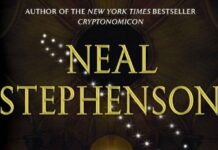
Ebook Info
- Published: 2009
- Number of pages: 152 pages
- Format: Epub
- File Size: 0.52 MB
- Authors: Neal Stephenson
Description
This is “the Word” — one man’s word, certainly — about the art (and artifice) of the state of our computer-centric existence. And considering that the “one man” is Neal Stephenson, “the hacker Hemingway” (Newsweek) — acclaimed novelist, pragmatist, seer, nerd-friendly philosopher, and nationally bestselling author of groundbreaking literary works (Snow Crash, Cryptonomicon, etc., etc.) — the word is well worth hearing. Mostly well-reasoned examination and partial rant, Stephenson’s In the Beginning… was the Command Line is a thoughtful, irreverent, hilarious treatise on the cyber-culture past and present; on operating system tyrannies and downloaded popular revolutions; on the Internet, Disney World, Big Bangs, not to mention the meaning of life itself.
User’s Reviews
Amazon.com Review Neal Stephenson, author of the sprawling and engaging Cryptonomicon, has written a manifesto that could be spoken by a character from that brilliant book. Primarily, In the Beginning … Was the Command Line discusses the past and future of personal computer operating systems. “It is the fate of manufactured goods to slowly and gently depreciate as they get old,” he writes, “but it is the fate of operating systems to become free.” While others in the computer industry express similarly dogmatic statements, Stephenson charms the reader into his way of thinking, providing anecdotes and examples that turn the pages for you. Stephenson is a techie, and he’s writing for an audience of coders and hackers in Command Line. The idea for this essay began online, when a shortened version of it was posted on Slashdot.org. The book still holds some marks of an e-mail flame gone awry, and some tangents should have been edited to hone his formidable arguments. But unlike similar writers who also discuss technical topics, he doesn’t write to exclude; readers who appreciate computing history (like Dealers of Lightning or Fire in the Valley) can easily step into this book. Stephenson tackles many myths about industry giants in this volume, specifically Apple and Microsoft. By now, every newspaper reader has heard of Microsoft’s overbearing business practices, but Stephenson cuts to the heart of new issues for the software giant with a finely sharpened steel blade. Apple fares only a little better as Stephenson (a former Mac user himself) highlights the early steps the company took to prepare for a monopoly within the computer market–and its surprise when this didn’t materialize. Linux culture gets a thorough–but fair–skewering, and the strengths of BeOS are touted (although no operating system is nearly close enough to perfection in Stephenson’s eyes). As for the rest of us, who have gladly traded free will and an intellectual understanding of computers for a clutter-free, graphically pleasing interface, Stephenson has thoughts to offer as well. He fully understands the limits nonprogrammers feel in the face of technology (an example being the “blinking 12” problem when your VCR resets itself). Even so, within Command Line he convincingly encourages us as a society to examine the metaphors of technology–simplifications that aren’t really much simpler–that we greedily accept. –Jennifer Buckendorff –This text refers to an alternate kindle_edition edition. From Library Journal Available for free download online at an Avon-sponsored website, this extended essay on computer operating systems by high-tech novelist Stephenson (Cryptonomicon) generated such demand that the server actually crashed. The audience for this title, though, is potentially much broader. Stephenson’s strength lies in making technical topics accessible; anyone who has used a mouse, typed a letter into a word processor, or developed an interest in the history of computers will be able to enjoy much of this book. He is weakest, however, in reining in his proseAthe ease of composing on a computer seems in his case to encourage logorrhea. The long-anticipated outcome of the government’s case against Microsoft may increase interest in Stephenson’s viewpoint that the inevitable tendency of computer operating systems is toward becoming both free and open. Buy where interest in technology issues is strong, although readers who pick up the book because of Stephenson’s name may wish that a firmer hand had edited the material.ARachel Singer, Franklin Park P.L., IL Copyright 1999 Reed Business Information, Inc. –This text refers to an alternate kindle_edition edition. From Publishers Weekly After reading this galvanizing essay, first intended as a feature for Wired magazine but never published there, readers are unlikely to look at their laptops in quite the same mutely complacent way. Stephenson, author of the novel Cryptonomicon, delivers a spirited commentary on the aesthetics and cultural import of computer operating systems. It’s less an archeology of early machines than a critique of what Stephenson feels is the inherent fuzziness of graphical user interfacesAthe readily intuitable “windows,” “desktops” and “browsers” that we use to talk to our computers. Like Disney’s distortion of complicated historical events, our operating systems, he argues, lull us into a reductive sense of reality. Instead of the visual metaphors handed to us by Apple and Microsoft, Stephenson advocates the purity of the command line interface, somewhat akin to the DOS prompt from which most people flee in a technophobic panic. Stephenson is an advocate of Linux, the hacker-friendly operating system distributed for free on the Internet, and of BeOS, a less-hyped paradigm for the bits-and-bytes future. Unlike a string of source code, this essay is user-friendlyAoccasionally to a fault. Stephenson’s own set of extended metaphors can get a little hokey: Windows is a station wagon, while Macs are sleek Euro-sedans. And Unix is the Gilgamesh epic of the hacker subculture. Nonetheless, by pointing out how computers define who we are, Stephenson makes a strong case for elegance and intellectual freedom in computing. (Nov.) Copyright 1999 Reed Business Information, Inc. –This text refers to an alternate kindle_edition edition.
Reviews from Amazon users, collected at the time the book is getting published on UniedVRG. It can be related to shiping or paper quality instead of the book content:
⭐ I must remember to check the dates on books like this before I jump at a good price deal. This book is now very long in the tooth. It covers what amounts to some history not so much of computers but of how users interact with them. Written almost 20 years ago now so much has changed and the nature of our interactions with information machines of all types has evolved so much that this short book ends up being mostly about ancient (in machine interaction terms) history.A few things haven’t changed much. Apple and Microsoft still fight it out in both corporate and personal markets, but Linux (evolved from Unix through GNU) has largely taken over the big server market with some competition from Microsoft. BE (which Stephenson liked) hasn’t been heard from in 15 years. There are still mainframes around, but these drop out of this story after the appearance of reasonably business-capable microcomputers. I began my career around the same time as Stephenson using paper teletypes, card stacks and glass TTYs.Stephenson’s thrust here is the change from typing words (or symbols) on a command line to what passed for modern graphical interfaces, Windows and the Macintosh in the late 1990s. Today’s users would still recognize these early departures from the command line. They were, after all, the beginning of the “graphical interfaces” we have today, But people would also recognize the Model T’s relation to the modern automobile and its evolution away from the horse and buggy. Windows NT (as far forward in time as this story goes) has about as much in common with the Microsoft Surface and the Mac Book Pro, not to mention Android, the IPAD, and the now evolving virtual reality interfaces as the Model T has to today’s cars.I had thought Stephenson was going to say something profound about those early graphics as goes their effect on human psychology, but he does not. He does mention the strong allegiances various groups had to particular operating systems and how these affected their markets, but again, while polarized allegiances are still very much in evidence, the particulars have changed radically. One might say that this book has value as history, but even at that it is woefully incomplete.In the 80s and early 90s there were a half dozen or more good, in terms of technology, not market share, competitors (in addition to BE) to MSDOS, Windows, and the Mac. Back in those days the hardware was not powerful enough to handle the rich sort of graphics and touch screens we all come to expect today, but clever operating system developers found ways around those limitations and produced graphic-like interfaces that were still basically text. Some of these had features not seen in even today’s advanced systems. Who here has heard of Oasis, or Pick? Stephenson never mentions them.So OK the book is a “history lite” of the user experience with computers and I can’t fault him for not anticipating the 21st Century back in 1999. But given that all he had to go on was the 30 years from roughly 1970 to 1999, he still leaves out a lot.
⭐ This is a brief history of, and commentary on, the development of computer operating systems in the context of the competing business models of Apple and Microsoft, and how newer freeware operating systems like Linux relate to these corporate structures. As with all of this author’s works, the writing is interesting and engaging. It is written for the lay-person, and I learned a lot from it. Published in 2009 and covering the state of affairs in the personal computer industry probably up to 2007-08, the book is now somewhat outdated. Much has happened in the past 10 years, the bulk of it not very good or encouraging. How about a sequel? Why has commonly used software like Microsoft Office passed the point of maximum efficiency in the user-to-operating-system interface? Why, with every new release, is it becoming increasingly cumbersome and dumbed-down to the point of uselessness.
⭐ On the surface this book is well past its prime. Stephenson penned this book back when Windows NT was new, so the technical advice is old, outdated etc. However that does not mean that the book is irrelevant. Here are my thoughts on why you should read this short, outdated, technically oriented book.Stephenson explores a number of themes behind the technology discussion that are interesting and worth your consideration. The primary one is the difference between people who seek to engage a system through the command line and those who want to use a GUI. The command line gives you access to the deep parts of a system, requires understanding and gives you control. The GUI is superficial etc.The reading helps you understand Stephenson’s other books, particularly SnowCrash. Its not as good as “Some Remarks” but it provides some insight.Its nostalgia for people who were active at the start of the PC computer revolution. Its easy to forget in this digital age, what it was really like at the start.Overall, not a book that you have to run out and buy right away. But something worth reading, I know I have been hovering around this book for some time and decided to pick it up. Glad that I did.
⭐ I am a fan of Neal Stephenson and work in the IT industry. This book seemed like a no-brainer for me. I ignored all the negative reviews, because those couldn’t be from real fans, could they? Wrong. Even when it came out, this was not a book – it was a rant. A long, repetitive rant. I’m so glad I’ve read so many of Stephenson’s other excellent books – if this were my first taste, I’d not have had that pleasure.First time Stephanson readers, don’t give up – pick up “Snow Crash” or “Diamond Girl” or “Anathem” or “Reamde” or “Cryptonomicon” or … well just don’t give up on him as an author. He is brilliant and versatile and you will find a book that suits your taste and understand why I and many others will keep reading his books.
⭐ Stephenson has an interesting style. If you were part of the era and technology this book covers, and are into nostalgia for those good old days, the style plus content might keep you entertained long enough to finish this brief work. But it was written for a pretty small audience and the world in which it is placed is but a faded memory even to them. While the fundamentals haven’t changed, much of this is historical, all of which is now trivia.
⭐ This book made me feel justified in my snobby opinions of Unix and low opinions of Windows and Mac. Considering it was written nearly 20 years ago, it’s quite insightful and predicts a lot of what happened with the business of operating systems since then. Stephenson’s analogies for everything from configuration files to the operating systems themselves are clever and easy to understand. His class analysis of the metaphors used in ui design were interesting even in today’s lense, where these topics are more a part of the collective consciousness. About as entertaining as a book on this subject could be.
⭐ As a hardware/software engineer I have worked with MS-DOS, Windows, MacOS, and UNIX for many years. Reading this fairly short, critical, and sometimes hysterically funny essay was an enjoyable experience, albeit I had some major reservations about some of Neal’s suppositions and conclusions.Stephenson presents, first of all, a rather simplified version of the history of PC computing world and the operating systems that have helped define and advance (or impede) the development of the PC from something that only a geek could love to a ubiquitous near-appliance. His definition of what an operating system is matches what most programmers, using common sense, would call an operating system: a suite of low level tools that perform the mundane tasks of interpreting what an application wants to do to the physical realm of reading/writing memory, disk files, displaying graphics, etc. This is not a trivial point, as the current insistence by Microsoft that its operating system is inclusive of web browsers, audio/video players, and other application-level programs is a key item in its anti-trust defense. However, Stephenson bypasses the relevance of this in favor of defining the differences between the MacOS, Windows, UNIX, and BeOS. For this purpose he uses a highly useful (and sometimes funny) metaphor defining each OS as a car dealership, each of whom sells their type of product to a different type of customer.One of his major points is the idea that an OS is a saleable product, even though in essence it is nothing but a long string of 1’s and 0’s, information only, and not a physical item, represents a paradigm shift, on the order of trying to sell a car’s driving interface (steering wheel, brakes, etc) as a product separate from, and having intrinsic value in its own right, the car itself. Given the obvious nonsense of this separation in the case of the car, he makes the case that operating systems should all eventually be given away free, ala Linux, and that businesses that depend on OS income are treading a very dangerous path.He shows a definite preference for those OSs that allow the user to ‘get under the hood’ and tweak its operating parameters, such as Linux, and includes a long discourse on the whole concept of simplified, pre-packaged interfaces as culturally defining/defined, including some good analogies with what Disney does to make complex, detailed subjects immediately comprehensible to Joe Six-Pack.All of this makes for easy, enjoyable reading, whether you are a power user or just someone who wants to send e-mails. But his conclusions about which OS is best and the future direction of OS evolution is definitely skewed towards the power user, someone who is comfortable in dealing with all the inner complexities of computers and software. As such, he sometimes forgets that computers are a tool (even though he devotes a section to different levels of tools in terms of quality , power and user skill levels), of no use to the user except insofar as they provide something that user wants and needs, and it is that end result the user wants, at the absolute minimum of fuss on his part.A thought provoking essay, whether you agree with him or not.
⭐ Although a bit out-of-date I enjoyed the romp through history and the final return “…under it all, even today, is the command line…” Like all of Mr. Stephenson’s writing it’s clear, enjoyable and his “voice” strikes a nice balance between telling and portraying.
⭐ While in the midst of getting through Stephenson’s Quicksilver I took a break to read this shorter, faster paced, work. I can’t go back and read/review this when it was first published. I wish I could, but I can’t. I can only review it as I enjoyed it current day. It is an argument to the strength of Stephenson’s prose that a shallow, dated essay on GUIs and command line operating systems even gets 3 stars 5 years after being published. Analogy and whimsy are well-used by Mr. Stephenson here in discussing the different types of users and how they wish to interact with the machine. He makes a dry subject entertaining. Unfortunately, this many years past publication the world has move greatly on. Yes the command line vs. GUI worldviews have not changed, but neither has the freeing of OS’s happened either. Additionally, beneath the whimsy and wordplay are only some nifty, but not fleshed out ideas almost laid down as truths. Stephenson needed to back up his ideas with some more evidence rather than thought experiment. Despite those faults though, it is an enjoyable, but now purposeless, read.
⭐ In the Beginning…Was the Command LineOriginally published in 1999, Neal’s essay on operating systems is, like most of his writing, multilayered and filled with palatable prose and a thought provoking potpourri of information that, especially in the case of this essay in book form, often requires rereading for proper digestion.Neal has a lot to say in Command Line.First and foremost, I walked away with the following impression: in the world of Neal, Windows is a necessary but doomed operating system. Neal explains why as only he can. He also tells you why Apple is doomed and Microsoft might be. Furthermore, Neal explains that there are better operating systems available and makes a case for why you might want to try them out: they are free, and they don’t crash. These two operating systems are Linux, which is a variant of UNIX and BeOS, which is the product of a mad Frenchman but which has many merits that outweigh the product’s French origins.Command Line is filled with memorable statements that sometimes border on or are in all actuality, profound.For instance – “Contemporary culture is a two-tiered system, like the Morlocks and the Eloi in H.G. Wells The Time Machine, except it has been turned upside down. In The Time Machine, the Eloi were an effete upper class supported by lots of subterranean Morlocks who kept the technological wheels turning. But in our world, it’s the other way round. The Morlocks are in the minority, and they are running the show, because they understand how everything works. The much more numerous Eloi learn everything they know from being steeped from birth in electronic media directed and controlled by book-reading Morlocks. That many ignorant people could be dangerous if they got pointed in the wrong direction, and so we’ve evolved a popular culture that is (a) almost unbelievably infectious, and (b) neuters every person who get infected by it, by rendering them unwilling to make judgments and incapable of taking stands.”In other words, Neal is saying, there are the people who read the book and there are the people who only watch the movie that is made about the book, and the people who read the book are the people who really know what the author was saying. The people who watch the movie don’t really get it, because they get the filtered version, the dumbed down version, the version built for mass consumption by those who are less intelligent or perhaps just not as focused.Command Line isn’t for everyone. It’s for Morlocks, or those who want to be Morlocks. If you’ve never owned a pocket protector, opened your computer case up or tinkered with the innards of any of the plethora of electronic devices you own, then you probably won’t consume this book with relish, as I did.Now, if you’ve stuck with my review to this paragraph, you likely are the type who will enjoy Command Line. Most importantly, you are, in all probability, the type to ponder on and eventually benefit from Neal’s closing, in which he compares God to an engineer and remind his readers that, “if you don’t like having your choices made for you, you should start making your own.”I came away from reading Command Line thoroughly convinced that I need to explore BeOS when I return from the war I’m currently fighting. And of course, I will continue making my own choices whenever possible, rather than letting others make them for me.Update: Since I wrote the review I’ve been talking to people and reading Neal’s web site. Two things are apparent to me: a) the book is very dated and b) Macintosh made the very smart decision to move their OS to a UNIX based product. This book will still be a highly enjoyable read if you have the soul of a nerd, as I do.
Keywords
Free Download In the Beginning…Was the Command Line in Epub format
In the Beginning…Was the Command Line Epub Free Download
Download In the Beginning…Was the Command Line 2009 Epub Free
In the Beginning…Was the Command Line 2009 Epub Free Download
Download In the Beginning…Was the Command Line Epub
Free Download Ebook In the Beginning…Was the Command Line




